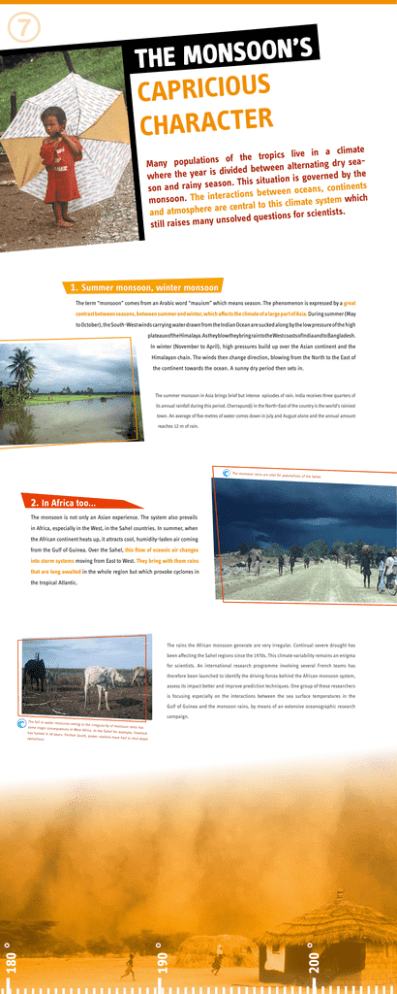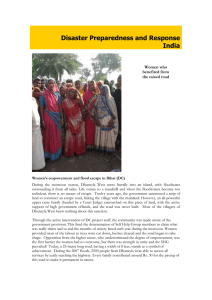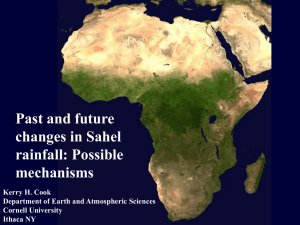CAPRiCiOUS CHARACTER THE MONSOON’S
advertisement

7 S ’ N O O S N O M E H T S U O I C I CAPR R E T C A R CHA e t a m li c a in e v li s ic p o r t e h t f o s eas y r d g Many population in t a n r e lt a en e w t e b d e id iv d is e h t y b d e n where the year r e v o g is n io t a u it s is h T . n o ts n e in t n o c son and rainy seas , s n a e c o en e w t e b s n io t c a r e t ich h w m e t s monsoon. The in y s e t a m li is c h t o t l a r t n e c e r a e . s t is t and atmospher n ie c s r o f s n tio s e u q d e lv o s n u y n still raises ma 1. Summer monsoon, winter monsoon The term “monsoon” comes from an Arabic word “mauism” which means season. The phenomenon is expressed by a great contrast between seasons, between summer and winter, which affects the climate of a large part of Asia. During summer (May to October), the South-West winds carrying water drawn from the Indian Ocean are sucked along by the low pressure of the high plateauxof the Himalaya.As theyblow theybring rain to the West coasts ofIndia and to Bangladesh. In winter (November to April), high pressures build up over the Asian continent and the Himalayan chain. The winds then change direction, blowing from the North to the East of the continent towards the ocean. A sunny dry period then sets in. The summer monsoon in Asia brings brief but intense episodes of rain. India receives three quarters of its annual rainfall during this period. Cherrapundji in the North-East of the country is the world’s rainiest town. An average of five metres of water comes down in July and August alone and the annual amount reaches 12 m of rain. The monsoon rains are vital for populations of the Sahel. 2. In Africa too... The monsoon is not only an Asian experience. The system also prevails in Africa, especially in the West, in the Sahel countries. In summer, when the African continent heats up, it attracts cool, humidity-laden air coming from the Gulf of Guinea. Over the Sahel, this flow of oceanic air changes into storm systems moving from East to West. They bring with them rains that are long awaited in the whole region but which provoke cyclones in the tropical Atlantic. The rains the African monsoon generate are very irregular. Continual severe drought has been affecting the Sahel regions since the 1970s. This climate variability remains an enigma for scientists. An international research programme involving several French teams has therefore been launched to identify the driving forces behind the African monsoon system, assess its impact better and improve prediction techniques. One group of these researchers is focusing especially on the interactions between the sea surface temperatures in the Gulf of Guinea and the monsoon rains, by means of an extensive oceanographic research campaign. 200 ° 190 ° 180 ° The fall in water resource s owing to the irregularit y of monsoon rains has some tragic consequenc es in West Africa. In the Sahel for example, livest has halved in 30 years. Fu ock rther South, power statio ns ha ve ha d to shut down operations.









